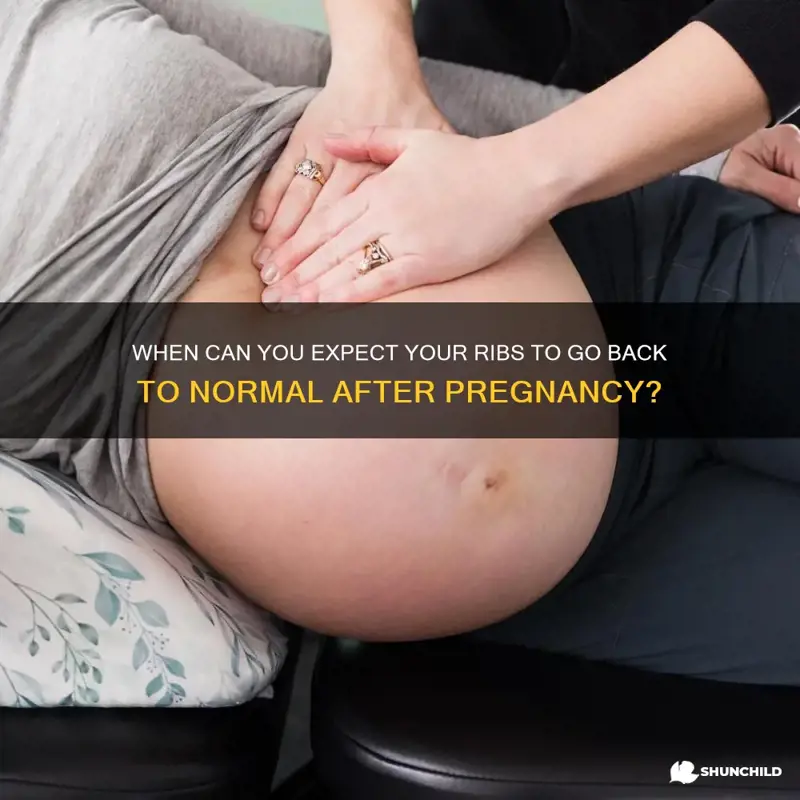
Pregnancy is a beautiful and transformative experience that brings many joys and challenges. One of the common physical changes associated with pregnancy is the expansion of the ribcage to accommodate the growing baby. But have you ever wondered how long it takes for the ribs to go back to their pre-pregnancy state? In this article, we will explore the fascinating journey of the ribs during and after pregnancy and discover how long it typically takes for them to return to their original shape.
| Characteristics | Values |
|---|---|
| Skin Changes | 6-12 weeks |
| Muscular Strain | 3-6 months |
| Ligament Healing | 4-6 months |
| Hormonal Changes | 6-12 months |
| Breastfeeding | 6-18 months |
| Abdominal Strength | 6-12 months |
| Overall Recovery | 1-2 years |
What You'll Learn

Physical Changes in Ribs During and After Pregnancy
During pregnancy, a woman's body undergoes numerous changes to accommodate the growing baby. While most people are aware of the visible changes like a growing belly, there are also other not-so-obvious changes happening in the body. One such change is the expansion of the ribcage.
The ribcage plays a crucial role in protecting vital organs like the heart and lungs. It is designed to be flexible, allowing the chest to expand and contract with each breath. However, during pregnancy, the ribcage expands to make room for the growing uterus, which can result in discomfort and pain for some women.
The expansion of the ribcage usually occurs during the second trimester and continues until the end of the pregnancy. This expansion is necessary to accommodate the growing baby and provide enough space for proper lung function. As the baby grows, the uterus pushes against the diaphragm and pushes the ribcage outwards and upwards.
After giving birth, many women expect their bodies to return to their pre-pregnancy state immediately. However, it is important to understand that the ribcage takes time to shrink back to its original size. On average, it can take anywhere from six to eight weeks for the ribs to gradually return to their pre-pregnancy position.
There are a few factors that can affect how long it takes for the ribcage to go back to normal. One of the biggest factors is the individual's body type and how much the ribcage expanded during pregnancy. Women who have a smaller frame or had a larger baby may experience a more significant expansion of the ribcage, which may take longer to revert.
Additionally, breastfeeding can also affect the timeline for the ribs to go back to their original position. The process of breastfeeding involves the production of the hormone relaxin, which loosens the ligaments and joints in the body. This hormonal change can further delay the shrinking of the ribcage.
While there is no surefire way to speed up the process of the ribcage returning to its pre-pregnancy state, there are some steps women can take to help alleviate discomfort and promote healing.
Firstly, it is important to practice good posture during pregnancy and after giving birth. Avoid slouching or hunching over, as this can put undue strain on the ribcage. Maintaining an upright posture can help support the ribcage and prevent further expansion.
Secondly, engaging in gentle exercises like yoga or walking can help strengthen the muscles around the ribcage and promote proper alignment. Strengthening the core muscles can provide additional support to the ribcage and aid in the healing process.
Lastly, wearing a supportive bra that fits properly can also provide relief and support to the expanded ribcage. Look for bras that offer adjustable straps and a wide band for added comfort.
It is important to note that every woman's body is different, and the timeline for the ribcage to return to its original position may vary. If you have any concerns about the changes you are experiencing, it is always best to consult with your healthcare provider. They can offer personalized advice and guidance based on your specific situation.
Ways to Alleviate Nipple Pain during the Second Trimester of Pregnancy
You may want to see also

Factors Affecting the Recovery Time for Ribs After Pregnancy
Pregnancy is a beautiful yet physically demanding process that can result in a wide range of changes in a woman's body. One of these changes that many women experience is the shifting and spreading of the ribs to accommodate the growing baby. While the ribs may return to their pre-pregnancy position over time, the recovery process varies from woman to woman. In this article, we will discuss the factors that can affect the recovery time for ribs after pregnancy.
- Individual Anatomy: One of the main factors influencing the recovery time for ribs after pregnancy is a woman's individual anatomy. Some women naturally have wider rib cages, while others have narrower ones. Women with wider rib cages may find that their ribs return to their pre-pregnancy position more quickly compared to women with narrower rib cages.
- Baby's Position: The position of the baby during pregnancy can also impact the recovery time for the ribs. Babies positioned higher in the uterus may put more pressure on the lower ribs, causing them to shift and spread more significantly. In such cases, the recovery process may take longer as the ribs need to readjust to their previous position.
- Multiple Pregnancies: Women who have had multiple pregnancies may find that their ribs take longer to recover compared to women who have had only one pregnancy. This is because the repeated stretching and spreading of the ribs with each pregnancy can result in more significant changes. Therefore, it is important for women who have had multiple pregnancies to be patient and give their bodies ample time to recover.
- Exercise and Core Strength: Engaging in regular exercise and strengthening the core muscles can greatly affect the recovery time for ribs after pregnancy. Strengthening the core muscles helps to support the ribs and realign them more quickly. However, it is important to consult with a healthcare professional before starting any exercise routine to ensure that it is safe and appropriate for your postpartum recovery.
- Posture and Breathing Techniques: Maintaining good posture and practicing proper breathing techniques can also aid in the recovery of the ribs. Slouching or hunching can impede the realignment of the ribs. On the other hand, maintaining an upright posture and practicing deep breathing exercises can help to stretch and open up the chest, allowing the ribs to gradually return to their pre-pregnancy position.
- Time: Lastly, time is a significant factor in the recovery of the ribs after pregnancy. Pregnancy and childbirth are significant events that place a tremendous amount of stress on a woman's body. It is important to be patient and give your body time to heal and recover. While some women may see their ribs return to normal within a few weeks or months, others may take several months or even longer. Each woman's body is unique, and the recovery time can vary.
In conclusion, the recovery time for ribs after pregnancy can be influenced by various factors such as individual anatomy, baby's position, multiple pregnancies, exercise, posture, and time. It is important to remember that every woman's experience is different, and you should consult with your healthcare provider for personalized advice and guidance. Be patient with your body and give yourself the time and space to recover fully.
Unveiling the Mystery: What Does Pregnancy Sweat Really Smell Like?
You may want to see also

Tips for Promoting Rib Healing and Recovery Postpartum
After giving birth, many women may experience discomfort or pain in their ribs. This is a common side effect of pregnancy and can be a result of the expanding uterus and increased pressure on the ribcage during pregnancy. While the exact time it takes for your ribs to go back to normal can vary, there are several tips and techniques you can use to promote rib healing and recovery postpartum.
- Rest and Take It Easy: One of the most important things you can do to promote rib healing is to rest and take it easy. Your body needs time to recover and heal after childbirth, and pushing yourself too hard can delay the healing process. Make sure to take breaks throughout the day and get enough sleep at night to give your body the rest it needs.
- Practice Good Posture: Maintaining good posture can help alleviate strain on your ribs and promote healing. Be mindful of your posture when sitting, standing, and breastfeeding. Sit up straight with your shoulders back and avoid slouching or hunching over. You can also use pillows or cushions for support while breastfeeding to help maintain good posture.
- Use Cold and Heat Therapy: Applying cold or heat therapy to your ribs can help reduce inflammation and promote healing. Use an ice pack or a bag of frozen peas wrapped in a thin towel to apply cold therapy to the affected area for about 15 minutes at a time. You can also use a heating pad or take a warm bath to apply heat therapy to your ribs.
- Practice Gentle Stretching and Breathing Exercises: Gentle stretching and breathing exercises can help promote rib healing and alleviate discomfort. For example, you can try gentle side stretches by raising your arms overhead and leaning to one side while taking deep breaths. This can help stretch the muscles around your ribs and improve circulation.
- Wear a Supportive Bra: Wearing a supportive bra can help provide additional support to your ribs and reduce discomfort. Look for bras that are specifically designed for postpartum or nursing women, as they often have extra support and padding. Make sure the bra fits well and does not dig into your ribs, as this can exacerbate discomfort.
- Consider Physical Therapy: If your rib pain persists or is severe, it may be beneficial to seek the help of a physical therapist who specializes in postpartum care. They can provide exercises and techniques specifically targeted at promoting rib healing and recovery.
- Take Over-the-Counter Pain Medication: If your rib pain is causing significant discomfort, you can consider taking over-the-counter pain medication such as acetaminophen or ibuprofen. However, always consult with your healthcare provider before taking any medication, especially if you are breastfeeding.
While it may take some time for your ribs to fully heal after pregnancy, following these tips can help promote healing and alleviate discomfort. Remember to be patient with your body and give it the time and care it needs to recover. If you have any concerns or if your pain persists or worsens, don't hesitate to reach out to your healthcare provider for further evaluation and guidance.
How to Alleviate Heartburn During Pregnancy at Night
You may want to see also

When to Seek Medical Attention for Rib Pain After Pregnancy
Rib pain after pregnancy is a common condition that many women experience. This discomfort can occur due to various reasons, including changes in the body during pregnancy and the physical demands of childbirth. While rib pain is often considered a normal part of the postpartum recovery process, there are situations when it becomes essential to seek medical attention.
One of the primary causes of rib pain after pregnancy is diastasis recti, a condition where the abdominal muscles separate during pregnancy to accommodate the growing baby. As a result, the diaphragm and ribs may become strained, leading to discomfort and pain. This pain typically subsides as the abdominal muscles heal and strengthen, but it may take several weeks or even months to fully recover.
In most cases, rib pain after pregnancy can be managed with simple self-care measures. These include:
- Rest and relaxation: It is essential to prioritize rest and allow your body to heal. Avoid activities that aggravate the rib pain and take breaks when needed.
- Good posture: Maintaining a good posture can help alleviate rib pain. Ensure that you sit and stand upright, and use proper body mechanics when lifting or carrying objects.
- Gentle exercises: Engaging in gentle exercises like walking, stretching, and pelvic floor exercises can promote healing and relieve rib pain. However, it is important to consult with a healthcare provider or a physical therapist before starting any exercise regimen.
- Dress comfortably: Wearing loose-fitting and comfortable clothing can reduce pressure on the ribs and provide relief.
While these self-care measures are often sufficient for managing rib pain after pregnancy, it is crucial to be aware of warning signs that may indicate the need for medical attention. If you experience any of the following, it is important to seek medical help:
- Severe or persistent pain: If the rib pain is severe or worsening over time, it may be a sign of underlying complications such as a rib fracture or an infection. Medical evaluation is necessary to determine the cause and appropriate treatment.
- Difficulty breathing: If you are experiencing shortness of breath or significant difficulty breathing along with rib pain, it is essential to seek immediate medical attention, as these symptoms may indicate a more serious condition like a pulmonary embolism or pneumonia.
- Swelling, redness, or warmth: If you notice any of these signs around your rib area, it could indicate an infection or inflammation. Prompt medical evaluation is necessary to prevent complications.
- Fever: If you have a high fever along with rib pain, it may be a sign of an infection. Seek medical attention to receive appropriate treatment and avoid further complications.
Remember, every woman's recovery process is different, and it is normal to experience some degree of discomfort or pain after pregnancy. However, if you have concerns or any of the warning signs mentioned above, do not hesitate to reach out to your healthcare provider. They will be able to assess your condition, provide necessary treatment, and offer guidance to help you recover effectively and safely.
Understanding the Timing of HCG Home Pregnancy Tests After Blastocyst Transfer
You may want to see also
Frequently asked questions
It varies from woman to woman, but on average it can take several weeks to several months for the ribs to go back to their pre-pregnancy position.
Breastfeeding itself does not directly affect the position of the ribs. However, the physical act of breastfeeding and the changes in posture that may occur while nursing could influence the timeline for the ribs to return to their normal position.
There are certain exercises and stretches that can help improve posture and potentially aid in realigning the ribs. Working with a physical therapist or postpartum exercise specialist can provide guidance on safe and effective exercises during this time.
It is not uncommon for women to experience residual discomfort or occasional soreness in the rib area even after the ribs have returned to their pre-pregnancy position. If the pain is severe or persistent, it is recommended to consult with a healthcare provider for further evaluation.







